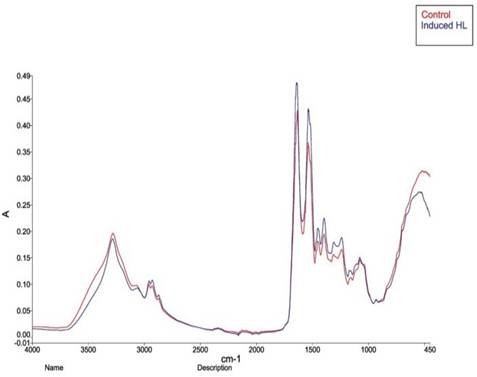Abstract
Clinical Diagnosis is the process that identifies a possible disease or disorder that can be diagnosed through analysing specific components with multiple techniques and procedures that identifies the internal physiological changes. FTIR-ATR is a non-invasive, reagent-free diagnostic tool which can be rapidly and simultaneously analyze several components in the biological fluids and organs and which can be employed in analyzing the biomolecules. Hypercholesterolemia was induced in Wistar rats by feeding the animals with the regular diet supplemented with 1% cholesterol and 0.5 % cholic acid saturated with coconut oil for 6 weeks. End of induction study, experimental animals were sacrificed for biochemical and FTIR- ATR spectral analysis. Experimental serum samples were analyzed immediately for spectral recordings in the Mid IR region of 4000-450 cm-1. The intensity of the olefinic =CH bond (3012 cm−1) can be used as an index of relative concentration of double bonds in the lipid structure from unsaturated lipids. The C=O stretching at 1740 cm−1 monitor the glycerol backbone near the aqueous part of the lipids. Results on biochemical variations obtained with both these methods were compared. Based on results obtained the study suggest that the FTIR-ATR technique might be an additional technique to know more details at molecular levels in the diagnostic sector. Further, this technique could be standardised for routine utility in disease diagnosis and management in the medicinal field.
Full text article
Generated from XML file
Authors
Saira Khatheeja A, Safiullah A, Surapaneni Krishna Mohan, Vishnu Priya V, & Prabhakaran AR. (2023). FTIR-ATR spectroscopy as a diagnostic tool in the diagnosis of hypercholesterolemia induced by cholesterol-rich diet in rats. International Journal of Research in Pharmaceutical Sciences, 9(3), 940–946. Retrieved from https://ijrps.com/home/article/view/4388
Copyright (c) 2018 International Journal of Research in Pharmaceutical Sciences

This work is licensed under a Creative Commons Attribution-NonCommercial-NoDerivatives 4.0 International License.

